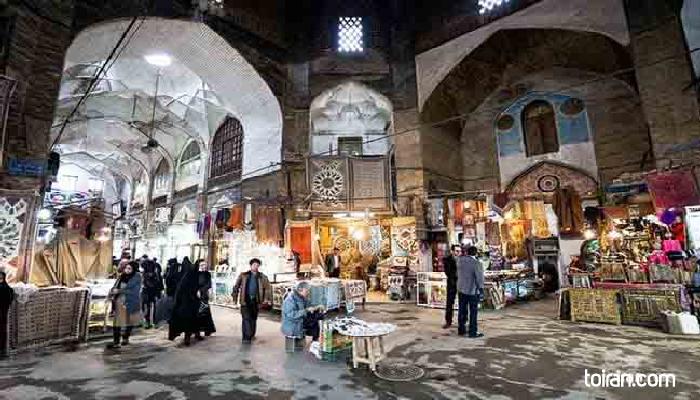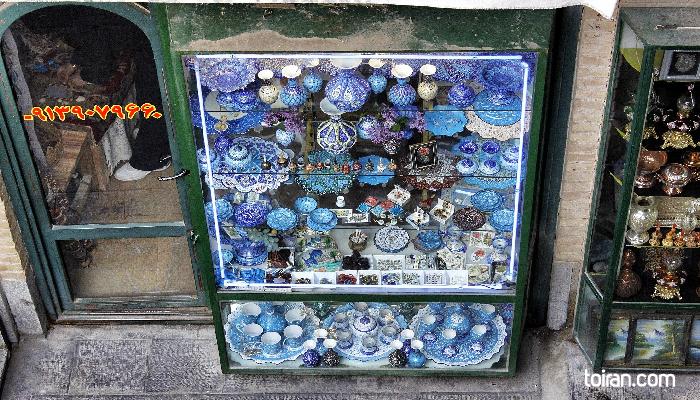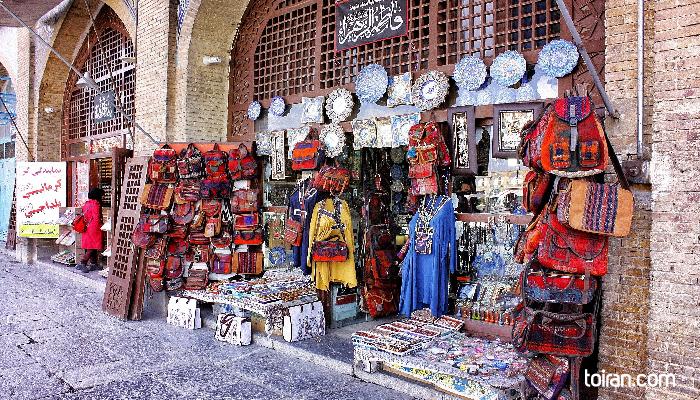Bazaars are one of the most important and central elements in every Iranian city. After mosques, these markets were considered the heart of each neighborhood as they were where people went to buy and sell goods, interact with one another and learn about the latest news and developments in the realm from the town criers walking around their passages to make public announcements. Most major cities had a main bazaar and each neighborhood had its own special, smaller bazaar. These bazaars often consisted of a long vaulted street with shops on either side.
One of the most magnificent bazaars of Iran and one of the oldest and largest in the Middle East is the 17th century Isfahan Bazaar. Located in the northern part of the Naqsh-e Jahan Square this two-kilometer vaulted street links the old and new texture of the city by connecting the main entrance called Qeisarieh with the city’s Jame Mosque.
Precious textiles, gems, carpets and different goods were sold and traded in this large bazaar, which was also known as the Imperial Bazaar. Poet, philosopher and traveler Naser Khosrow (1004 – 1088 CE) in his Safarnama (Travel Book) described this bazaar as a place where 200 Saraf (money changers) worked.
Above the portal of Qeisarieh Bazaar is a tribune that once accommodated musicians giving public concerts. There are two platforms on either side of the entrance, where hundreds of years ago jewelers and goldsmiths sat to sell their merchandise.
Qeisarieh has been built in two stories, the top was used for administrative affairs and the first story was where shops were lined up and merchants worked. Qeisarieh includes the six smaller Harounieh, Oryan, Nimavard Golshan, Mokhles, Samovarmakers and Maqsoud Beik bazaars.
The bazaar also includes several mosques namely Dualfaghar, Now and Shisheh where merchants from different guilds performed daily prayers, a number of schools such as Kaseh Garan, Harounieh, Nimavard and Mula Abdollah, and sub-bazaars such as Golshan, Jarchi, and Fakhr. This bazaar also has scores of caravanserais, where Silk Road travelers would stop along the way to rest.
There are shops in this bazaar which have been in business and sold the same goods for over 400 years. Today, this bazaar is the largest handicraft market in Isfahan and offers a variety of goods including Persian carpets, handmade silver jewelry and spices among other commodities.
The bazaar has been registered along with Naqsh-e Jahan Square as a UNESCO World Heritage Site.







Spent a day here and seriously didn't notice the time passing by :)
You have to visit the Bazaar to get the sense of history in this place. it's always alive and crowded and handicrafts are like nowhere else. Simply Captivating
You can find anything here, it's amazing :) you feel you are walking through history. I went for traditional rugs and couldn't decide where to buy one :) so many variety of products every where you go :)
As the tourism booms in Iran, you will find shopkeepers in Gheisarieh Bazaar have already adapted to the flow of tourists. for example, every carpet shop we visited recently had at least one or two young salesmen speaking English, French or Dutch fluently and that was a nice surprise for us. You can also find new and small Cafe's opening beside traditional Tea houses in the Bazaar offering you the brewed Italian Coffee, all and all it was clear to us how this Bazaar have continued to exist and hold it's importance through the years by adapting to changes. You can just go for stroll in this amazing place and loose track of time easily.
My favorite part of the visit to Isfahan is going to this bazaar and just strolling for hours in the busy streets here:) from sweets to carpets you can find almost anything here :)
هنوز در بازار اصفهان صدای چکش کوبیدن مسگرها به گوش میرسه و این واقعا زیباست. این بازار منحصر به فرد جایی هست که می توان از نزدیک هنر را دید و همانجا هم خرید کرد. معماری دوره صفویه بازار واقعا زیباست.
You can find anything here and there are several amazing traditional restaurants in here. i bought alot of sweets :) (Gaz)
I love it how tradition and modernity is mixed here and you can enjoy a perfectly brewed coffee here or have traditional tea at the next stop :)
I visit the bazaar each time visiting Isfahan. it is an amazing experience and so much history here.
We love going to this bazaar and besides shopping, there are lots of traditional tea houses where you can sit and enjoy the ambiance in this place.
Perfect place to buy Iranian handicrafts and also the most delicious sweets you can imagine :)